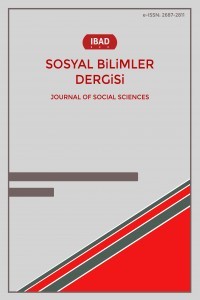EMPRICAL EXAMINATION OF THE TURKISH TRADE DEFICIT
The objective of this study is to investigate Turkey’s trade deficit through examining the dynamics of trade balance in order to understand which of the variables deteriorate this deficit and also in what manner these variables affect trade balance. In this respect, the real exchange rate effect on trade balance both in the short run and long run has been examined by using quarterly data set from 1992 to 2011 for Turkey. The Vector Error Correction Model (VECM) is applied with Johansen co-integration analysis, Granger causality test and generalized impulse response analysis. According to Johansen cointegration analysis, under trace and maximum eigenvalue tests variables found cointegrated which means there is long run relationship among variables. This result enables us to apply VECM.
Anahtar Kelimeler:
Trade deficit, VECM, Johansen co-integration analysis, J Curve
___
- Akbostancı, E. and G.I. TUNÇ (2002), “Turkish Twin Deficits: an Error Correction Model of Trade Balance,” ERC Working Papers, 01(06).
- Akbostancı, E (2002), “Dynamics of the Trade Balance: The Turkish J-Curve.” ERC Working Papers, 02/05
- Akhtar, M. ve Hilton R. S (1984), “Effects of Exchange Rate Uncertainity on German and U.S. Trade”, Federal Reserve Bank of New York, Quarterly Review, 9 Alptekin, V. (2009). “Türkiye’de Dış Ticaret ve Reel Döviz Kuru İlişkisi: Vektör Otoregresyon (VAR) Analizi Yardımıyla Sınanması” Niğde Üniversitesi İİBF Dergisi Cilt: 2, Sayı: 2, s.132-149 Arize, A. C. (1994), “Cointegration Test for a Long-run Relation between the Real Effective Exchange Rate and the Trade Balance.” International Economic Journal Volume 8, No:3 Bahmani-Oskooee, M. (1991), “Is There a Long-run Relation Between the Trade Balance and the Real Effective Exchange Rate of LDCs?” Economic Letters, 403- 407.
- Boyd, Derick, and Caporale, Gugielmo Maria and Smith Ron (2001) “Real Ex change Rate Effects on the Balance of Trade: Cointegration and the Marshall-Lerner Condition,” International Journal of Finance and Economics, 6, 187-200.
- Chinn, M. and Wei, S-J. (2008), “A Faith-based Initiative: Do We Really Know that a Flexible Exchange Rate Regime Facilitates Current Account Adjustment?” NBER Working Paper, No. 14420.
- Demir M. and Sever E. (2007) “Türkiye’de Bütçe Açığı ile Cari Açık Arasındaki İlişkilerin VAR Analizi ile İncelenmesi” Eskişehir Osmangazi Üniversitesi İİBF Dergisi, Nisan 2007, 2(1): 47-63
- Erkılıç, S. (2006), “Türkiye’de Cari Açığın Belirleyicileri (Uzmanlık Yeterlilik Tezi)” (Ankara:Türkiye Cumhuriyet Merkez Bankası İstatistik Genel Müdürlüğü).
- Goldstein, M. and Khan M.S. (1985). “Income and Price Effects in Foreign Trade”, Handbook of International Economics, Vol II: 1041–1105
- Işiker M., (2012), The effect of exchange rate on trade deficit, Queen Mary University, London, 110536848
- Kimbugwe, H. (2006). "The bilateral J-Curve hypothesis between Turkey and her 9 trading partners," MPRA Paper 4254, University Library of Munich
- Onafowora, O. (2003), “Exchange Rate And Trade Balance in East Asia: Is There A J Curve?,”Economics Bulletin, 5(18): 1-13.
- Peker, O. and Hotunoğlu H. (2009), “Türkiye’de Cari Açığın Nedenlerinin Ekonometrik Analizi,” Atatürk Üniversitesi, İ.İ.B.F. Dergisi, 23(3): 221–237.
- Rose, A.K and Yellen, J.L (1989). “Is There a J-Curve?” Journal of Monetary Economics 24, 53-68.
- Vergil, H. (2002). “Exchange Rate Volatility in Turkey and Its Effect on Trade Flows.” Journal of Economic and Social Research 4 (1), 83–99
- Yapraklı S. (2010) “The Determinants of Foreign Trade Deficits Under Floating Exchange Rate Regime: Bounds Test Approach” Ankara Üniversitesi Siyasal Bilgiler Fakültesi Dergisi, 2010; 65(4): 143-163
- Yayın Aralığı: Yılda 2 Sayı
- Başlangıç: 2016
- Yayıncı: Hayrullah KAHYA
Sayıdaki Diğer Makaleler
LİZBON ANTLAŞMASI’NIN AB’NİN KURUMSAL YAPISINA ETKİLERİ
MEVSİMSEL BİTKİ GÖRÜNÜMLERİNİN TERCİH VE ALGISAL FARKLILIKLARININ BELİRLENMESİ
Emine TARAKÇI EREN, Elif Merve ALPAK, Tuğba DÜZENLİ
MESLEK YÜKSEKOKULU ÖĞRENCİLERİNİN ETİK DEĞERLERE YATKINLIK DÜZEYLERİ (KOCAELİ MYO ÖRNEĞİ)
Burcu ÜZÜM, Serpil ÖZKURT SİVRİKAYA
KÜLTÜR VE KÜLTÜR BOYUTLARININ İNOVASYON KAPASİTELERİ ÜZERİNE ETKİLERİ
ÖRGÜT KÜLTÜRÜ VE LİDERLİK TARZI ARAYIŞINDA, YENİ ARGÜMANLAR: MANİSA VESTEL FABRİKASINDA BİR ÇALIŞMA
SANATSAL CAMLARDA KEMİK TOZU KULLANIMI
